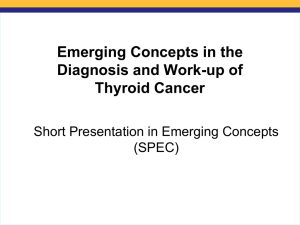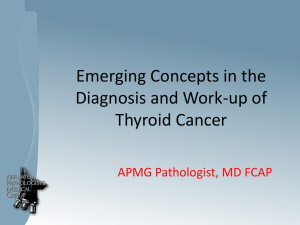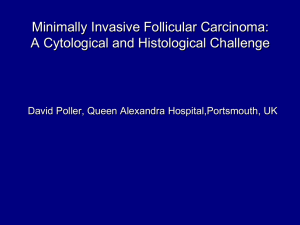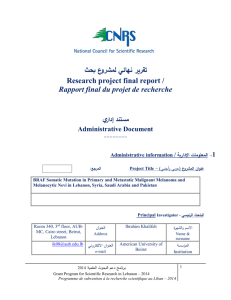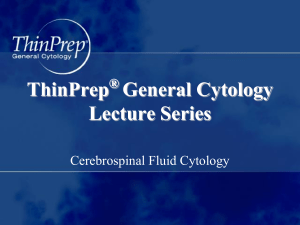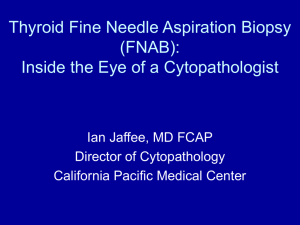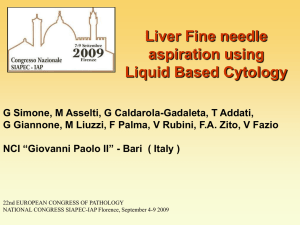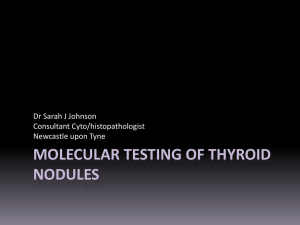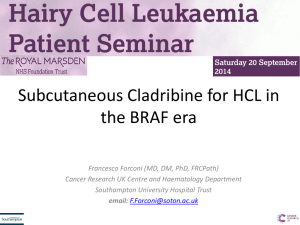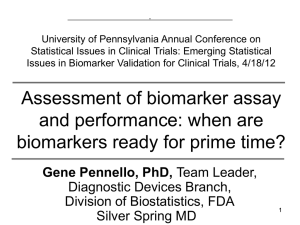Diapositiva 1
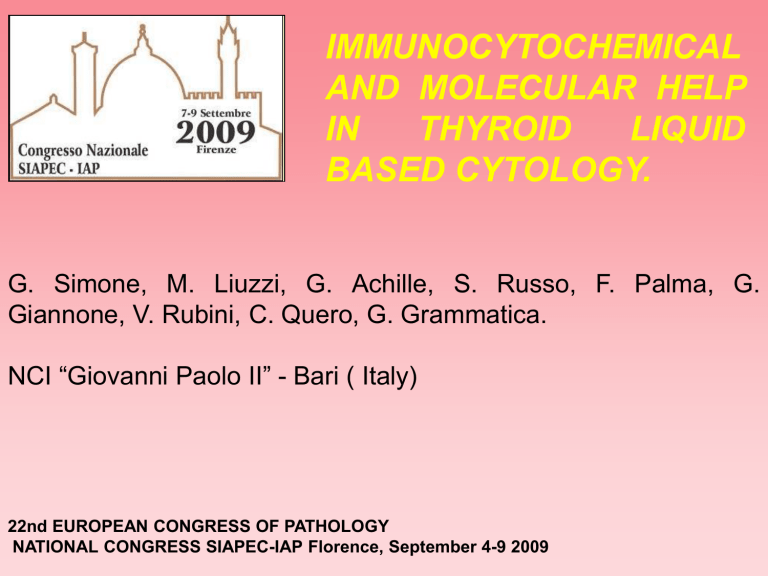
IMMUNOCYTOCHEMICAL
AND MOLECULAR HELP
IN THYROID LIQUID
BASED CYTOLOGY.
G. Simone, M. Liuzzi, G. Achille, S. Russo, F. Palma, G.
Giannone, V. Rubini, C. Quero, G. Grammatica.
NCI “Giovanni Paolo II” - Bari ( Italy)
22nd EUROPEAN CONGRESS OF PATHOLOGY
NATIONAL CONGRESS SIAPEC-IAP Florence, September 4-9 2009
INTRODUCTION
Fine Needle Cytology (FNC) is the most important tool in the diagnosis of thyroid nodules.
It has been demonstrated that Liquid Based Cytology (LBC) improves the quality of the smears and the diagnostic accuracy, also because of well preserved cellularity useful to immunocytochemical (ICA) or molecular assays (MA).
The aim of the study is to verify the potential help of ICA or MA on LBC, when applied on indeterminate or malignant Thyroid
FNCs.
MATERIAL AND METHODS
101 Patients who underwent thyroid FNCs entered the study
89 females and 12 males (mean age: 44.7; Fem 46.4;
Males 43); Echography: 72 nodules were single, whereas 29 nodules were the major in multinodular thyroids
The material was processed in Thin Prep 2000 TM.
48 Samples were available for HBME-1 using ICA
48 Different samples were available for BRAF gene mutation
(V600E) detection, using MASA technique
5 Samples of the same Patients were available for HBME-1 and BRAF determination
101 FNCs were classified according to SIAPEC classification.
Surgical samples of all FNCs were available for cyto-histological correlation
MATERIAL AND METHODS
Patients
Females
Males
Mean Age
Single Nodule
Multinodular
N.
89
12
44.7
72
29
Assays
FNCs
HBME-1 assays
BRAF assays
HBME-1 and BRAF assays
5
N.
101
48
48
RESULTS
Out of 101 FNCs, 75 were classified as “Follicular Lesions” (THY
3) and 26 as Papillary Thyroid Carcinoma (PTC).
The cyto-histological correlation showed an Overall Agreement
(O.A.) of 89.1% (p<0.001) (Tab.1).
In 53 LBCs, the prevalence of HBME-1 expression was 45.2%
(Tab. 2) and the O.A. with histological diagnosis resulted 87%, versus 91% according to Cytology (Tab 3).
In the other 53 cases, the prevalence of BRAF mutation was
24.5% (Tab. 4) and the O.A. with histological diagnosis resulted
87% (p <0.001), the same than according to Cytology (Tab 5).
The Positive Predictive Value for PTC was 96.2%, 70.8% and
100% for Cytology, HBME-1/ICA and BRAF/MA, respectively.
In 5 cases, where both HBME-1 and BRAF mutation were investigated, 2 PTCs were HBME-1 positive and BRAF mutated whereas, the remaining 3 cases (2 Adenomas and 1 Hyperplastic
Nodule) were negative for both the markers.
Table 1. CYTO-HISTOLOGICAL CORRELATION IN 101
THYROID FNCs
Histology
Benign Malignant
10
TOT
75 Cytology Follicular 65*
Malignant 1 25 26
TOT 66 35 101
*36 Thy 3 resulted in Adenomas and 29 in Hyperplastic Nodules in adenomatous goitre.
Cytology PPV = 96.2%
O.A.: 89.1%; p < 0.001
Table 2. HBME-1/LBC VERSUS HISTOLOGY: CORRELATION
OF 53 CASES
Histology
Benign Malignant TOT
HBME-1/
L B C
Negative
Positive
29 0 29
7* 17 24
TOT 36 17 53
*The 7 FNCs resulted in: 2 IPM Follicular Lesions, 2 Adenomas and 3 hyperplastic nodules)
PPV = 70.8%
O.A. : 87%; p < 0.001
Table 3. CYTO-HISTOLOGICAL CORRELATION OF 53 CASES
WITH HBME-1 IMMUNOCYTOCHEMICAL ASSAY
Histology
Benign
Cytology Follicular 35
Malignant 1*
Malignant
4
13
TOT 36 17
*1 False Positive case was HBME-1 Negative
PPV = 92.9%
O.A. = 91%; p<0.001
TOT
39
14
53
Table 4. BRAF mutation VERSUS HISTOLOGY:
CORRELATION ON 53 CASES
Histology
Benign Malignant TOT
BRAF Wild-type
Mutated
TOT
33
0
33
7
13
20
40
13
53
PPV = 100%
O.A. = 87%; p<0.001
Table 5. CYTO-HISTOLOGICAL CORRELATION OF 53 CASES
WITH BRAF DETERMINATION
Histology
Benign
Cytology Follicular 33
Malignant 0
TOT 33
*4/7 cases showed BRAF-mutation;
** 4/13 cases resulted wild type
PPV = 100%
O.A. = 87%; p<0.001
Malignant
7 *
13**
20
TOT
40
13
53
Case 1
1a 1b
Fig. 1a: Inderterminate Thyroid FNA (See also * in Table 5 ) resulted in papillary cancer at histology, as observed in thin layer
(LBC).
Fig. 1b: The same case of 1a, as observed in conventional smear
(Thin Prep, Cytic Co., Papanicolau Stain, 400x)
1d
1c
Fig. 1c: Histological control: Papillary Thyroid Cancer (HE 400x)
Fig. 1d: BRAF mutation as detected by PCR, Mutant Allele
Specific Amplification (MASA) technique: the electrophoretic run
Case 2
2a
2b
2c 2d
PTC (Fig. 2a) and HBME1 Immunoreactivity (Fig. 2b) on LBC and on the corresponding surgical sample (Fig. 2c and 2d)
Case 2: V600E exon 15 BRAF mutation as detected by direct sequencing
CONCLUSIONS
Our study showed that Immunocytochemical and molecular assays can be successfully applied on monolayered smears, on well preserved cells obtained by LBC; they could increase diagnostic accuracy in thyroid FNC.
However, these markers evidenced some limits in relation to the lower specificity and PPV of HBME1 (Positive also in follicular adenomas) as well as for the low sensitivity of the BRAF mutation.
In our experience, the HBME 1 appears to be still usefull in reducing the diagnosis of “ Indeterminated Nodule”.
Moreover, in particular follicular lesions, when a diagnosis has to be confirmed, MASA technique showed to be an available tool, according to the absolute PPV of the BRAF mutation in PTC
22nd EUROPEAN CONGRESS OF PATHOLOGY NATIONAL
CONGRESS SIAPEC-IAP Florence, September 4-9 2009
